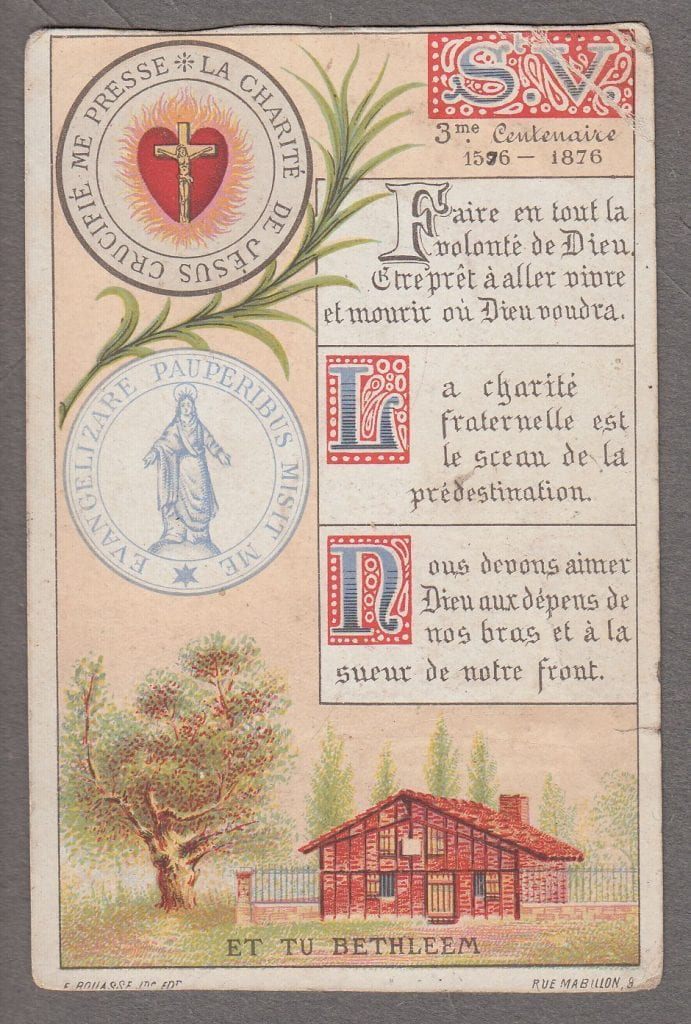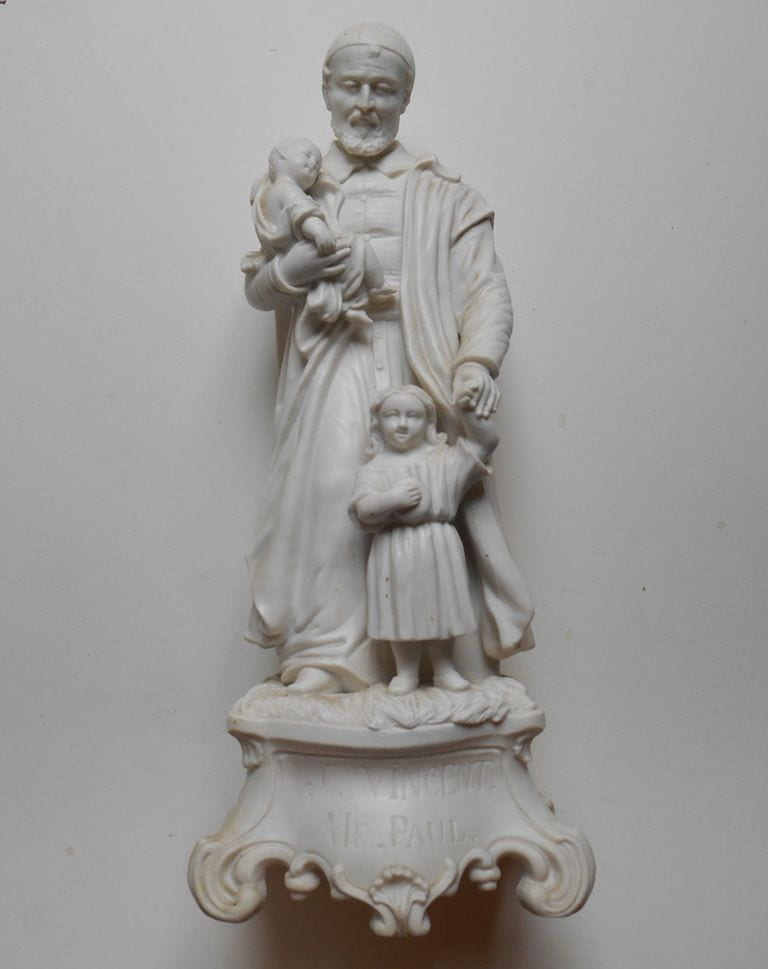Rev. Edward R. Udovic C.M. talks about his newest book, a translation and contextualization of the funeral homily for Vincent de Paul.
The Key to Happiness
By: Samreen Ahmed
According to Eleanor Roosevelt, “Happiness is not a goal; it is a byproduct of a life well-lived.” So by this definition, it is something that is not a firm emotion but rather it is achieved through action. Now the question I would like to present is– what are you doing to contribute to your happiness?
Our society tells us that money and prestige are what we need to be happy. With our money we can buy whatever we want, thus fulfilling all of our needs. And with prestige, nobody will dare doubt our worth because they know that we are above them. But what happens when your money doesn’t satisfy you? And when the people don’t respect you? Surely happiness is the last emotion you will be feeling in those moments of despair. Money and prestige only bring you temporary happiness, but there is a void that is not filled within you if you are not conscious in handling the two. Money should be spent wisely, and given to charity when possible because no matter how much money we spend, we are never satisfied. We spend and spend to make ourselves “happy” on things that contribute to everything but benefiting our hearts. And as for prestige, people respect us and honor us, but oftentimes we do not respect ourselves. The people’s opinions of us serve as a placeholder for our lack of respecting ourselves.
I believe happiness is achieved through our tears, our struggles and how we are truly delivered from our despair. Happiness to me is my mother’s smile. Happiness to me is my best friend’s hug. Happiness to me is the homeless man’s blessings to the people who ignore him. It is that sense of independence and freedom from all things that deter us from love and compassion. It is being grateful to something or someone when times get rough. It is that conviction of faith through your toughest nights and that warm feeling of ecstasy during your good nights. Happiness is not a constant emotion but it is a process. And it truly is a by-product of a life well-lived.
Sinking in Struggles
By: Olivia Hollman
One of the biggest lessons I’ve been learning this academic year is about struggles and how to deal with them. Between the combination of adding two jobs to the stress of school work, shifting relationships with friends, worry about the future financially, changing dynamics with family, and personal concerns, I’ve had a fair share of struggles this year. During those times, it feels as if I am in an ocean. I go from successfully treading water to starting to sink when the waves swell up, larger and more powerful than before. I try to stay afloat, but I can barely keep my head above the water. Right before I go under, I begin to cry for help and raise my arms in the air. Then I am saved.
In Matthew (Chapter 14), Jesus’ disciples are out in a boat when they see Jesus (they first think it is a ghost) walking on water. Peter gets out of the boat and begins walking towards Jesus, but becomes frightened of how strong the wind is and starts to sink. Peter cries out, ““Lord, save me!” Immediately Jesus stretched out his hand and caught him, and said to him, “O you of little faith, why did you doubt?”” (Mt 14:30-31) In my times of struggles, I get scared…I doubt… I lose faith…I start to sink; I forget that there is someone there to save me.
When I cry for help, Jesus pulls me out of the water and saves me. His help manifests itself to me through my community—my friends, coworkers, staff advisors, and family. When what I am going through seems too much for me to handle on my own, when I just don’t know what to do, when I just need someone to lean on, I am reminded that I am never alone in my struggles. The water can never completely pull me down, because I have the out-stretched hand of Jesus in the form of my community to catch me and embrace me.
St. Vincent de Paul and Money
The economic structures of seventeenth-century France, Vincent de Paul’s financial management, and his theory behind it are explained. His financial responsibilities and the sources of income for the Confraternities of Charity, the Congregation, and the Daughters of Charity are enumerated. In general, Vincent viewed money as a resource to be husbanded for the benefit of persons who were poor.
“Saint Vincent de Paul and Money” is an article published in the Vincentian Heritage Journal, Volume 26, Issue 1, Article 7 and is available at: https://via.library.depaul.edu/vhj/vol26/iss1/7
Book of the Week: “Le Premier Concile Plenier Chinois Shanghai 1924.”
- Dimensions : 135x215x30
- ISBN : 9782204092050
- Poids : 540 grammes
Paul Wang Jiyou, Chinois catholique, est un canoniste. Né au Liaoning, l’ancienne province de Mandchourie, en 1965, soit un an avant la révolution culturelle, il a été ordonné prêtre catholique romain latin en Chine en 1990. Après un temps comme curé de paroisse, l’archevêque de Shenyang l’a envoyé à Paris, où il devint en 2009 docteur en droit canonique et docteur de l’université française en histoire du droit. Il est spécialiste de la médiation de la canonicité missionnaire en matière d’inculturation et d’acculturation. Il est secrétaire général adjoint du département “Asie du Consortium international” Droit canonique et culture de la faculté de Droit canonique de l’Institut catholique de Paris.
St. Vincent’s Mirror Imagery of Christ’s Ministry
The Rev. Jack Melito, C.M., presents a reflection on some of the direct parallels between Jesus’ ministry and that of Saint Vincent de Paul’s. He points out such themes as their efforts for develop a sense of mission among their followers, the great global scope of their missions, and the emphasis on their mission to the poor.
“Saint Vincent’s Mirror Imagery of Christ’s Ministry” is a chapter in the book, Saint Vincent de Paul: His Mind and His Manner, by Fr. Jack Melito, C.M., published in 2010 by the Vincentian Studies Institute at DePaul University in Chicago, IL. Unfortunately, this book is currently out of print.
Newsnote: Vincentiana Purchase of the Week “Vincent’s birth centennial (corrected) 1576-1876
In 1981 the Vincentian family celebrated the 400th anniversary of the birth of Vincent de Paul. The 1581 date resulted from the definitive refutation of the previous date of 1576. The three hundredth anniversary had been celebrated in 1876 as illustrated by this new commemorative card recently purchased for the Vincentiana collections at the Archives and Special Collections of DePaul University.
Saint Vincent and Saint Louise, Catholic to the Core
DePaul University’s Vincent and Louise House community is a “residential faith formation program” in which students “engage more fully in the Christian faith, community service, social justice, and stewardship.” Following the examples of Vincent de Paul and Louise de Marillac, members of the house learn about and take part in the spiritual practices necessary for putting faith into action. The article details the community service they perform, how their commitments to social justice and stewardship are carried out, and what effect these activities have on the students. The program’s goal is to transform students, their worldview, and their perspective on their vocation within the tradition of Vincent and Louise. Students’ own words on the value of their experience in the house are included.
“Saint Vincent and Saint Louise, Catholic to the Core: Spiritual Praxis as the Foundation for Social Change” is an article published in the Vincentian Heritage Journal, Volume 28, Issue 2, Article 24 (2008) available at: https://www.via.library.depaul.edu/vhj/vol28/iss2/24
Social Justice Beats
by Katie Brick
“Hammer and a Nail” by the Indigo Girls came through my car radio this weekend. I was whisked back to doing community service – or thinking about doing service – in my 20s. And then I thought about theme songs from various DePaul Service Immersion Trips I’ve been on.
With new Spring Service Immersions just around the corner, and DCSA and Loop Community Service happening all the time I’d like to share my top 5 songs about service and invite YOU to add to the list via the comments!
In no particular order (and mostly stuck in a pop groove so do add hip hop, metal, show tunes, whatever):
“Hammer and Nail” by the Indigo Girls – fresh as a spring breeze while you’re painting on a service site.
[youtube https://www.youtube.com/watch?v=yTI2GGNFR_U&w=420&h=315]
“A distant nation my community
A street person my responsibility
If I have a care in the world I have a gift to bring.”
“Blessed to Be A Witness” by Ben Harper – Introduced to this one by students on a service trip to the slums of Guayaquil, Ecuador, where we encountered families living on garbage dumps, tens of thousands of people living in shacks with no running water, and Jenny, a local activist who looked everyone in the eye and demanded, “¿Por qué estás aquí?” (Why are you here?).
[youtube https://www.youtube.com/watch?v=0EK10z0y_1k&w=560&h=315]
“Only by the grace of God go I.
I am blessed to be a witness.”
“What’s Going On” by Marvin Gaye – I remember this from being a kid and its call to action seems just as timely now with #BlackLivesMatter, continuing war, and fears putting us at odds with compassion and solidarity. You have to have an interest in ‘What’s goin’ on’ to get involved.
[youtube https://www.youtube.com/watch?v=H-kA3UtBj4M&w=420&h=315]
“Mother, mother
There’s too many of you crying
Brother, brother, brother
There’s far too many of you dying.”
“You Get What You Give” by the New Radicals – My older brother, whose life is incredibly difficult right now and all about service, recently put this on a mix for me. It’s catchy.
[youtube https://www.youtube.com/watch?v=uc6jd9P1X6w&w=560&h=315]
“Wake up kids
We’ve got the dreamers disease.”
“Hands” by Jewel. Yes, Jewel. It’s in the same genre as “Hammer and Nail,” granted – so share your own genres in the comments, and enjoy this in the meantime.
[youtube https://www.youtube.com/watch?v=AfsS3pIDBfw&w=420&h=315]
“We are God’s eyes
God’s hands
God’s mind
We are God’s eyes
God’s hands
God’s heart”
Katie Brick is the Director of the Office of Religious Diversity at DePaul University.




